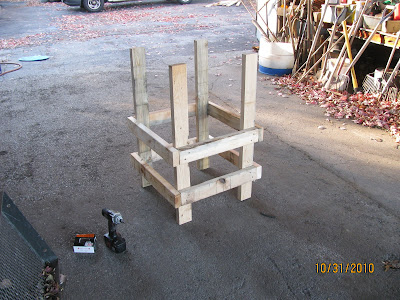Sunday was a beautiful day with sunny skies and a temperature hovering around 80, not bad for the mountains this time of year. After a late breakfast at Cracker Barrel with a colleague, I headed off for Valley Falls State Park again. This time, though, I didn't go down to the river. Instead, I headed up a mountain away from the river. On a poorly maintained trail circling the mountain and inclining most of the way, I quickly gained altitude, although did not get a good overhead view of the river due to the trees.
The trail branched many times as I made my way higher, and I kept taking the left branch until I meandered into a creek that feeds into the river. Much like the river, the creek was a series of waterfalls coming down the mountain, including one rather tall and scenic twin waterfall with a large pool beneath. I put down my backpack and carefully worked my way out into the middle of the creek teetering precariously on a very slippery, mossy stone to take photos of the falls. Then, having retrieved my bag, I inched my way across a downed tree trunk to the other side of the creek to check out some old brick ruins that were situated along the bank.
Making my way back to another branch, I continued along the creek for some ways, admiring the rhododendron trees that flanked both banks. At one point, the trail crossed the creek at a shallow ford, although there were stone pylons of what once was a bridge beside it. My thinking is that the trail I was on had been a road at one point many years ago. In the end, I hiked seven miles around the mountain, half of it up and half down. It took me about two hours, including the time I spent at the creek taking pictures. When I returned to my car, I was tired and sore, but already planning my next trip to explore the other trail branches, especially the one marked Rocky Trail that led straight up the mountain side to the top rather than gradually inclining around the mountain.
 The trees are changing colors. The drive through the mountains to the park was spectacularly scenic.
The trees are changing colors. The drive through the mountains to the park was spectacularly scenic. The tallest falls of the creek, taken from a slippery rock in the middle of the creek.
The tallest falls of the creek, taken from a slippery rock in the middle of the creek. The first view of the creek I had from the trail. I knelt on some rocks and dipped my hand in the water. It wasn't as cold as I thought it would be.
The first view of the creek I had from the trail. I knelt on some rocks and dipped my hand in the water. It wasn't as cold as I thought it would be. That is the tree I used to cross over to the other side of the creek. It isn't very big of a tree and before I made it all the way across, my weight began to break the branches.
That is the tree I used to cross over to the other side of the creek. It isn't very big of a tree and before I made it all the way across, my weight began to break the branches. This is the most unusual of the brick ruins near the creek. It is a circular foundation made of bricks. It was half full of water and had a dead beaver floating in it.
This is the most unusual of the brick ruins near the creek. It is a circular foundation made of bricks. It was half full of water and had a dead beaver floating in it. One of the stone pylons of the bridge that once was. Everything was covered in moss. The trees weren't very close to each other, but their canopies blocked out most of the sunlight, so there was very little underbrush. I could have hiked just about anywhere.
One of the stone pylons of the bridge that once was. Everything was covered in moss. The trees weren't very close to each other, but their canopies blocked out most of the sunlight, so there was very little underbrush. I could have hiked just about anywhere. An ugly mug in a beautiful place.
An ugly mug in a beautiful place.






























